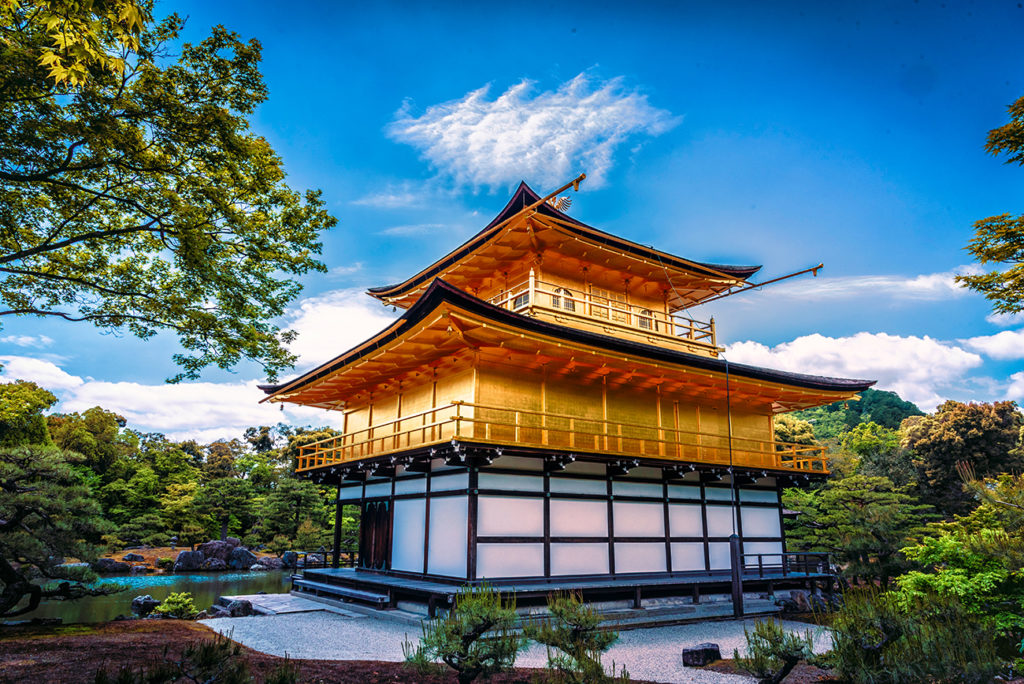
Popular Shrines and Temples in Japan
Japan contains a plethora of religious architectural structures—Kyoto alone is believed to have more than 2,000 shrines and temples. But it is not only in the big cities where you can find majestic Buddhist temples and shrines; nearly every Japanese village has its own shrine or temple. Famous temples usually charge admission fees and close by 16:00. Most Japanese shrines and temples are set in beautiful gardens and are often connected to local festivals.
Meiju Jingu Shrine (明治神宮)
One of Tokyo’s most famous shrines, the Meiju Shrine is a striking contrast to the hustle and bustle of the metropolis, with more than 120,000 evergreen trees blocking the city’s noise. If you are in Tokyo, make sure to see this shrine. Not only is the Meiju Shrine readily accessible through Harajuku Station; it’s also near the city’s fashion capital. At the northern part of the shrine’s grounds, you come across the Meiju Jingu Treasure House, a collection of some of the personal belongings of Emperor Meiju and Empress Shoken.
Senso-ji Temple
Sensoji Temple (浅草寺)
Also known as Asakusa Temple, Sensoji is a popular Buddhist temple built in the early 7th century. Along the temple walkway, visitors pass by the famous Nakamise, a shopping boulevard of local snacks and souvenir items. After reaching the Hozomon Gate, guests are greeted with the sight of a five-story pagoda and the main hall. Various events are held in Sensoji all year round. People flock to the place during the Asakusa Shrine Festival and the Sanja Matsuri.
Hase Kannon Temple (海光山慈照院長谷寺)
Officially known as Kaikozan Jishoin Hase-dera, the Hase Kannon Temple is situated on a hill in Kamakura with a magnificent view of the sea. It is home to the giant statue of Kannon, the Japanese deity of mercy.
The statue itself is considered one of the biggest wooden monuments in Japan, at 30 ft. tall. The statue’s eleven heads symbolize the phases of the Buddhist enlightenment process. Jizodo Hall features small monuments to Jizo Bodhisattva, who is believed to help the souls of children reach paradise.
Kotoku-in Temple
Kotoku-in Temple (高徳院)
The Kotoku-in houses the Great Buddha, an outdoor bronze monument of Amida Buddha that dates back to 1252. The temple buildings were destroyed several times by tidal waves and typhoons in the 14th and 15th centuries. The Great Buddha statue weighs around 93 tons and is 13.35 meters high.
Toshogu Shrine (東照宮)
Nikko’s main attraction, the Toshogu Shrine was built in honor of Tokugawa Ieyasu, the country’s most powerful shogun. Faced in sheets of gold-leaf, this World Heritage Site is considered one of Japan’s most opulent and elaborate shrines. Unlike other Shinto shrines of minimalist architectural style, Toshogu is an intricate mix of gold, color, and carvings, with dancing maidens, sages, birds, and flowers chasing one another along the building walls.
Kiyomizudera Temple (清水寺)
Also known as the Pure Water Temple, Kiyomizudera is one of the country’s most celebrated temples. It is best known for its wooden stage with a spectacular view of beautiful maple and cherry trees in the fall. The main hall is ringed by a large veranda that juts out onto the hillside and offers majestic views of the city. Kiyomizudera, Yasaka Shrine, and other temples in the area sponsor evening illuminations during the Hanatoro event in March.
Kinkakuji Temple
Kinkakuji (金閣寺)
Also known as the Temple of the Golden Pavilion, Kinkakuji is a Zen Buddhist temple in northern Kyoto. Kinkakuji is a three-story building build on the Rokuon-ji complex. Its upper stories are elaborately covered with real gold leaf. Kinkakuji is set in a Japanese garden and pond that shows the building’s reflection. The temple grounds were designed according to Buddha Amida’s principles of Western Paradise that illustrate harmony between the heavens and earth.
Horyuji Temple (法隆寺)
Popularly known as the Temple of the Flourishing Law, Horyuji (c.607 CE) is one of the oldest wooden buildings in the world. At present, the temple is composed of two areas, the Sai-in on the west and the To-in on the east. The west side of the temple features the Kondo (sanctuary hall) and the five-story pagoda. The To-in area includes an octagonal hall. The complex also houses lecture halls, monk’s quarters, dining halls, and libraries.
Kotohira-gu Shrine (金刀比羅宮)
Popularly tagged Konpira-san, Kotohira-gu Shrine is located in the western part of Kagawa at an altitude of 520 meters. Its inner shrine is accessible via 1368 stone steps. Pilgrimage to the shrine was a popular tradition in the Muromachi Period that continues to this day. Kotohira-gu Shrine houses important Japanese cultural artifacts and edifices including the Heian statue of Kannon Bosatsu and the four-ink paintings of Maruyama Okyo.



